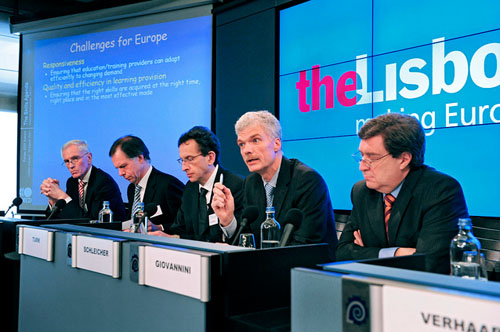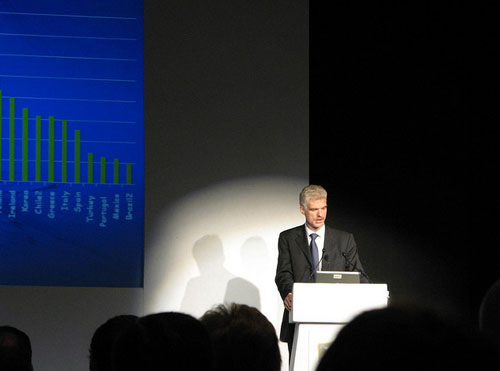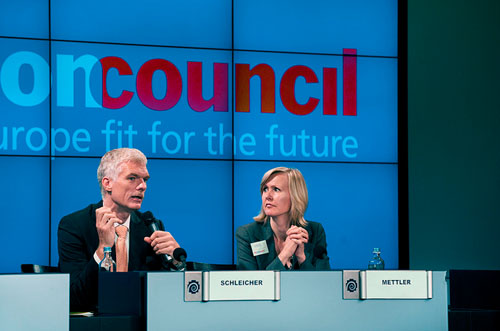
According to Andreas Schleicher of OECD, the United States is unique among countries in that the generation of workers entering the US workforce does not have higher college attainment levels than the generation about to leave the workforce. He further believes a key strategy to addressing this problem is improving equitable access to education across the board and that good examples of how to achieve this can be found in other education systems such as Finland, Canada, Japan or Korea. None of this sounds particularly new, but I wondered if Andreas were making the big picture education decisions, how would he address some of our key issues? We recently had the opportunity to discuss this further.
Andreas Schleicher is Special Advisor on Education Policy to OECD’s Secretary-General, and is Deputy Director for Education. He also provides strategic oversight over OECD’s work on the development and utilization of skills and their social and economic outcomes. This includes the Programme for International Student Assessment (PISA), the OECD Survey of Adult Skills (PIAAC), the OECD Teaching and Learning International Survey (TALIS), and the development and analysis of benchmarks on the performance of education systems (INES).

Should government provide tuition free education from pre-school through college?
There is no free education; someone has to pay. If governments provide free education from pre-school through college, they need to back that up with a steeply progressive tax system so that the better qualified people end up paying the bill eventually. The Nordic countries in Europe show that this can work, and work well. The other good option is to ask students to pay tuition and to back that up with a universal student support system that provides an income-contingent loan system complemented with a scheme of means-tested grants. In that way you minimize risks for students, avoid that they end up with huge debt that they cannot pay back, and you provide special assistance to those students who would otherwise be prevented from attending university. The UK shows how this can work. Providing college tuition-free without getting the money back through taxes for the better-educated means that the poor end up subsidizing the education of the rich.
Are you in favor of privatizing public schools?
Results from PISA show no performance advantage of private schools, once you account for social background. However, cross-country analysis of PISA suggests that the prevalence of schools’ autonomy to define and elaborate their curricula and assessments relates positively to the performance of school systems, even after accounting for national income. School systems that provide schools with greater discretion in deciding student assessment policies, the courses offered, the course content and the textbooks used are also school systems that perform at higher levels. So perhaps the question for countries is not how many private or charter schools they have, but how they enable every public school to assume charter-type responsibility.

Since every child is probably not meant to pursue a liberal arts education, what would you do to make our children more competitive in the skilled trade jobs market?
Our data show that when employers are involved in designing curricula and delivering education programs at the post-secondary level, students seem to have a smoother transition from education into the labor market. Compared to purely government-designed curricula taught in school-based systems, learning in the workplace offers several advantages: it allows trainees to develop “hard” skills on modern equipment, and “soft” skills, such as teamwork, communication and negotiation, through real-world experience. Hands-on workplace training can also help to motivate disengaged youth to stay in or re-engage with the education system. Workplace training also facilitates recruitment by allowing employers and potential employees to get to know each other, while trainees contribute to the output of the training firm. Workplace learning opportunities are also a direct expression of employers’ needs, as employers will be ready to offer opportunities in areas where there is a skills shortage.

Do you think that the United States needs to do more in the area of early childhood education, and if so, what?
One the one hand, the US falls well behind most countries in the industrialized world when it comes to early childhood education, and this is clearly a key lever to raise quality and equity in learning outcomes. At the same time, the US does really well when you look at student performance in primary education, so-so when it comes to performance in middle school, and not very well when it comes to performance in high school. This suggests that students actually get quite a strong start, but the school system adds less year after year than what children in other countries learn. That is something you don’t address with better early childhood education but with a better school system.
What do you think is the best way to fund our public schools?
The US spends plenty of money on public schools, but our data show three things. First of all, a disproportionally high share of that spending does not make it into the classroom. Secondly, spending is regressive in that schools in disadvantaged areas end up with less resources than schools in socially advantaged areas (in virtually all other industrialized countries it is the other way around). This does not allow the US to attract the most talented teachers into the most challenging classrooms, which would make public spending most effective. Third, high performing countries tend to prioritize the quality of teachers and the size of classes. The trend in the US over the last decade has gone the other way around.

Photos courtesy of OECD.
In The Global Search for Education, join me and globally renowned thought leaders including Sir Michael Barber (UK), Dr. Michael Block (U.S.), Dr. Leon Botstein (U.S.), Professor Clay Christensen (U.S.), Dr. Linda Darling-Hammond (U.S.), Dr. Madhav Chavan (India), Professor Michael Fullan (Canada), Professor Howard Gardner (U.S.), Professor Andy Hargreaves (U.S.), Professor Yvonne Hellman (The Netherlands), Professor Kristin Helstad (Norway), Jean Hendrickson (U.S.), Professor Rose Hipkins (New Zealand), Professor Cornelia Hoogland (Canada), Honourable Jeff Johnson (Canada), Mme. Chantal Kaufmann (Belgium), Dr. Eija Kauppinen (Finland), State Secretary Tapio Kosunen (Finland), Professor Dominique Lafontaine (Belgium), Professor Hugh Lauder (UK), Professor Ben Levin (Canada), Lord Ken Macdonald (UK), Professor Barry McGaw (Australia), Shiv Nadar (India), Professor R. Natarajan (India), Dr. Pak Tee Ng (Singapore), Dr. Denise Pope (US), Sridhar Rajagopalan (India), Dr. Diane Ravitch (U.S.), Richard Wilson Riley (U.S.), Sir Ken Robinson (UK), Professor Pasi Sahlberg (Finland), Andreas Schleicher (PISA, OECD), Dr. Anthony Seldon (UK), Dr. David Shaffer (U.S.), Dr. Kirsten Sivesind (Norway), Chancellor Stephen Spahn (U.S.), Yves Theze (Lycee Francais U.S.), Professor Charles Ungerleider (Canada), Professor Tony Wagner (U.S.), Sir David Watson (UK), Professor Dylan Wiliam (UK), Dr. Mark Wormald (UK), Professor Theo Wubbels (The Netherlands), Professor Michael Young (UK), and Professor Minxuan Zhang (China) as they explore the big picture education questions that all nations face today. The Global Search for Education Community Page
C. M. Rubin is the author of two widely read online series for which she received a 2011 Upton Sinclair award, “The Global Search for Education” and “How Will We Read?” She is also the author of three bestselling books, including The Real Alice in Wonderland.
Follow C. M. Rubin on Twitter: www.twitter.com/@cmrubinworld

Recent Comments